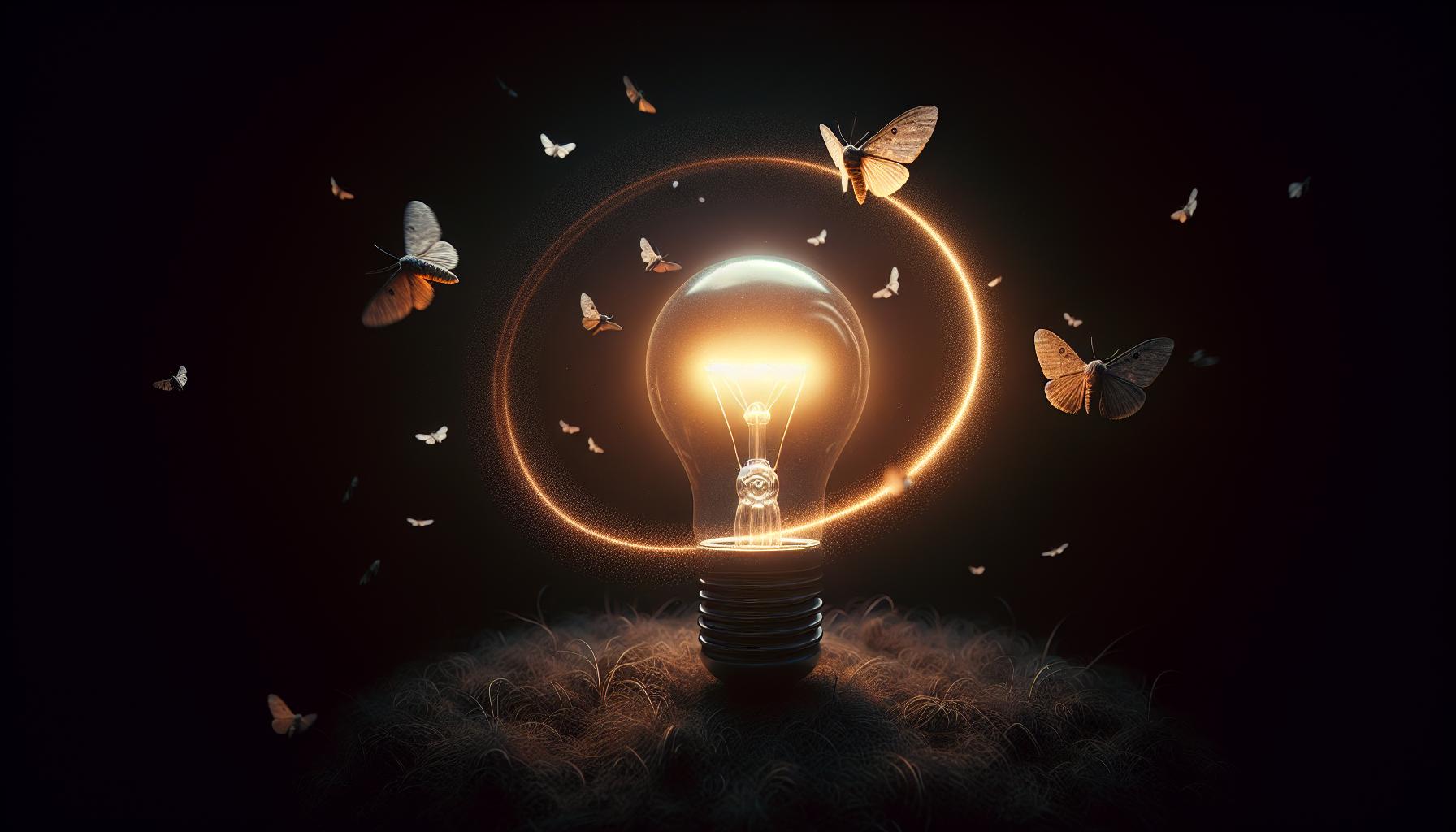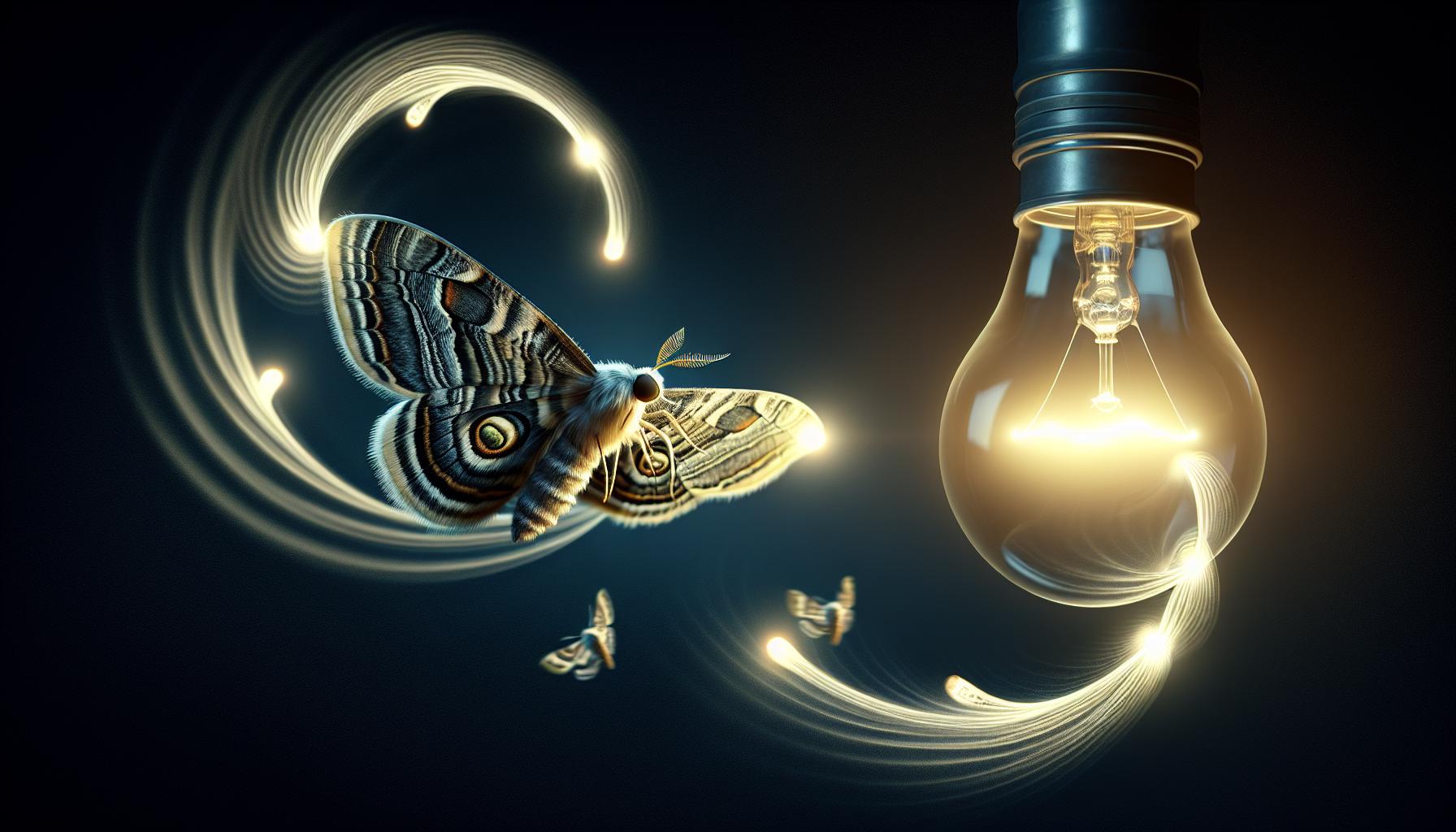Ever wondered why moths seem to be hopelessly attracted to your porch light? You’re not alone. It’s a peculiar sight, these fluttering insects dancing around bulbs with unwavering dedication.
Turns out, there’s a method to their moonlit madness. Your light bulb is more than just a beacon in the night for these creatures—it’s a confusing signal that they can’t resist.
The Attraction of Moths to Light Bulbs
You’ve probably noticed moths fluttering around your porch light during a warm summer evening. There’s a reason for this nighttime dance. Moths are strongly attracted to light bulbs and this attraction can seem almost hypnotic.
Why Do Moths Flock to Bulbs?
Light bulbs emit wavelengths that mimic those of natural light, from moonlight to starlight. Moths, like many nocturnal insects, use these celestial bodies to navigate the night sky. Your porch light, unfortunately, throws a wrench into their navigation system. Moths use transverse orientation, flying at a constant angle relative to a light source, which is adaptive for celestial navigation. However, an artificial light source like your porch light bulb sends mixed signals and causes them to spiral toward it.
Types of Light Bulbs and Moth Behavior
Depending on the type of bulb you use, you might notice a variance in moth traffic. Studies suggest that LED lights attract fewer moths compared to incandescent bulbs, which emit more infrared radiation. If you’re into DIY projects, consider switching your outdoor lights to:
- Warm-colored LEDs
- Low-pressure sodium vapor lamps
- Shielded fixtures to direct light downward
These changes can reduce your porch’s popularity among moth populations without leaving you in the dark.
Practical Considerations for Home Lighting
When you choose bulbs for your home, you should also consider:
- Energy efficiency
- Longevity of the bulb
- Impact on insect behavior
Balancing these factors can help you make an informed decision that’s good for your utility bill and local ecology. Remember, lighting isn’t just about visibility; it’s about creating a balance with the natural world right outside your door. By picking the right bulb, you not only save energy but also reduce light pollution that affects moths and other nocturnal wildlife.
The Science Behind Moth Attraction
Diving into the world of moths and their nightly escapades, you’ll find a mesmerizing behavior pattern that’s puzzled scientists for years. The reason moths seem to be in a trance-like state around lights isn’t due to adoration but disorientation. Moths have evolved to travel by the illumination of the moon and stars. This method of navigation, called transverse orientation, allows them to keep a constant angular relationship to a bright celestial light, ensuring they fly straight.
Now picture a bright porch light or an outdoor lamp post. To a moth’s simple navigation system, it’s like stumbling across a star on the ground. Their hardwired instincts compel them to maintain a consistent angular relation to that light—hence, the spiraling flight patterns around bulbs that you so often see.
Due to the different wavelengths emitted by various light bulbs, their attractiveness to moths varies significantly. Interestingly, LED lights, known for their energy efficiency, emit less of the UV spectrum that moths find irresistible. On the other hand, your standard incandescent bulb is a moth magnet, radiating a broad spectrum including UV light, infrared, and visible light.
Here’s something to lighten up your DIY projects—by switching to “warmer” colored LED bulbs, you’re not just saving on your electricity bill; you’re also creating a less enticing beacon for these winged creatures.
Practical Light Recommendations:
- Opt for LED bulbs with a color temperature of 2700K to 3000K, which emit a warm, yellowish light.
- Consider yellow-tinted bulbs designed to be less attractive to insects.
- Use motion-activated lights to minimize the time your lights are on, reducing the window of attraction for moths.
« How to Check Light Bulbs with a Multimeter: Fix Your Lights Like a Pro
Where Do Light Bulbs Go Shopping? Find the Brightest Options Online vs. In-Store »
By making these mindful lighting choices, you’re contributing to a solution that’s beneficial for your home, your energy consumption, and the night-time ecosystem that we seldom consider but is so vital to nature’s balance.
Phototaxis: Moths and Light
Have you ever noticed how moths seem to dance around a porch light like it’s their private disco? This behavior is known as phototaxis, which is an organism’s automatic movement toward or away from light. Moths, like many other insects, are positively phototactic—meaning they’re irresistibly drawn to light sources. The reasons are still not fully understood, but scientists believe it’s connected to their navigation.
Moths evolved to navigate by moonlight and stars, using the celestial light for orientation. When they come across an artificial light, their instincts kick in, and they mistake it for natural light. The brighter the light, the more moths you’ll see fluttering around. That’s why your porch light is a moth hotspot.
As a lighting enthusiast and an avid DIYer, you likely know that not all bulbs are created equal. LED lights are a phenomenal innovation not just because of their energy efficiency but also because they attract fewer moths compared to traditional incandescent bulbs. Here’s a quick comparison:
| Bulb Type | Attraction Level |
|---|---|
| Incandescent Bulbs | High |
| Compact Fluorescents | Medium |
| LED Bulbs | Low |
When choosing lighting for your outdoor areas, consider the color temperature and wavelength of the light. Warmer, yellow-tinted lights with a color temperature around 2700K tend to be less appealing to moths. Additionally, some bulbs are coated to filter out the UV and blue spectrum, which is less attractive to these nighttime fliers.
If you’re planning your next home lighting project, remember that the color and type of your outdoor bulbs can make a big difference. Opting for LED bulbs, especially those with a lower color temperature or with a protective coating, can minimize the moth mayhem. Plus, you’ll score energy savings and help maintain the delicate balance of the night ecosystem around your home, something that’s sure to make any DIY enthusiast’s heart swell with pride.
Behavioral Adaptations of Moths
As a savvy home DIY enthusiast and a lighting aficionado, you’re always curious about the interplay between nature and artificial environments. When it comes to moths, their behavioral adaptations are particularly fascinating. These nocturnal creatures have evolved complex behaviors that make them masters of surviving in the dark.
Attraction to Light Sources: It’s not simply a preference; moths have a survival instinct that draws them to the brightest point in their panorama. Traditionally, this would be the moon or stars, serving as a reliable navigational beacon. Now, however, artificial lights have thrown a wrench in their navigational systems.
Flight Path Control: Moths control their flight path by keeping a constant angle with respect to a light source, a behavior known as transverse orientation. When they encounter an unexpected artificial light, their orientation goes haywire, causing them to spiral inward towards the bulb.
In the face of these challenges, you’d think moths might shy away from illuminated areas, right? But that’s not the case. Their adaptability extends to changing their behavior based on the type of light and its intensity. Here’s what research suggests about their adaptive responses:
- Light Color Preference: Moths tend to be less attracted to certain wavelengths of light. For example, LED bulbs emitting a yellow-tinged light, which mimics the spectral quality of sunset, seem less enticing.
- Intensity and Distance: Brightness of the bulb and the distance from the light source also play crucial roles. The brighter the light and the closer a moth is to it, the stronger its attraction.
Understanding these adaptations can help you make more informed choices for your outdoor lighting setup. By tweaking the color temperature and the position of your light fixtures, you not just make your space more comfortable—you actually play a role in reducing the impact on these fluttering visitors of the night.
Conclusion
So you’ve seen how moths’ age-old navigation habits are thrown off by our modern lights. It’s fascinating to think that something as simple as changing your light bulbs could make a difference in their world. By opting for LED bulbs with a yellow tint, you’re not just saving energy; you’re also helping these nocturnal creatures stay on course. Next time you look at a moth fluttering around your porch light, remember it’s not a dance of joy but a sign of confusion. Let’s light our nights thoughtfully and keep the skies friendly for our winged neighbors.
Frequently Asked Questions
Why are moths attracted to light?
Moths use natural light sources like the moon and stars for navigation. They are instinctively drawn to light, mistaking artificial lights for these celestial guideposts, which disrupts their flight path control.
How do artificial lights affect moths?
Artificial lights can confuse moths, causing them to fly towards the light. This disrupts their natural navigation system, as they evolved to orient themselves using the consistent light of the moon, not the erratic lights produced by humans.
Do moths exhibit a preference for certain types of light?
Yes, moths show different levels of attraction to various types of light. They are less attracted to LED bulbs that emit a yellow-tinged light compared to brighter and whiter lights.
Can we reduce the impact of outdoor lighting on moths?
Understanding moth adaptations allows for informed decisions on outdoor lighting setups. Choosing lights that are less attractive to moths, like yellow-tinged LEDs, can help reduce their disorientation and preserve their behavior.
What is the significance of understanding moth behavior?
By understanding moth behavior and their attraction to light, we can better manage artificial lighting to minimize negative impacts on their populations and prevent disruption of their natural behaviors.




